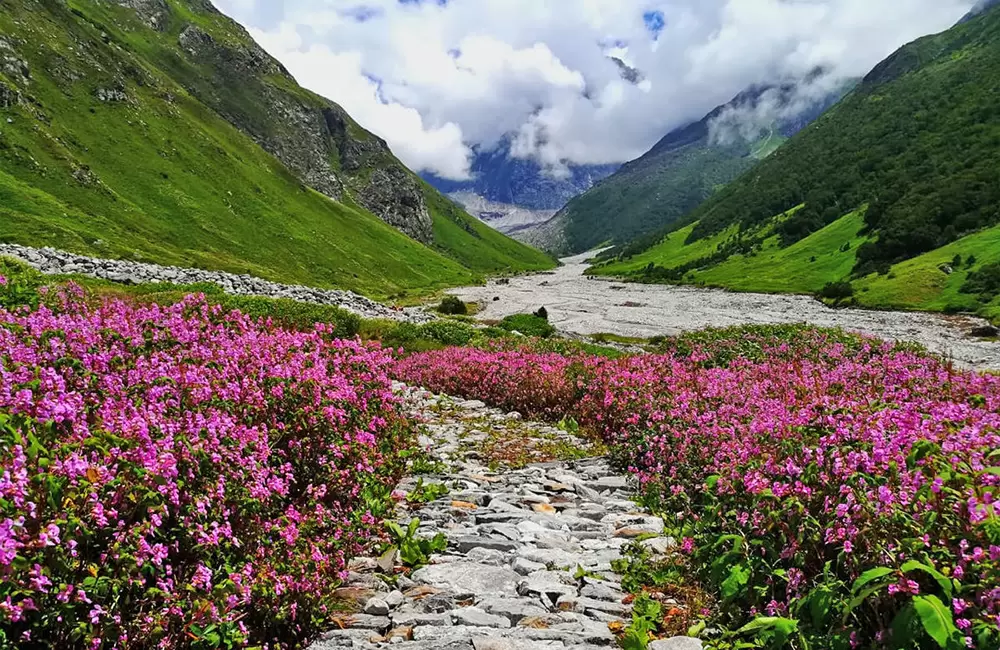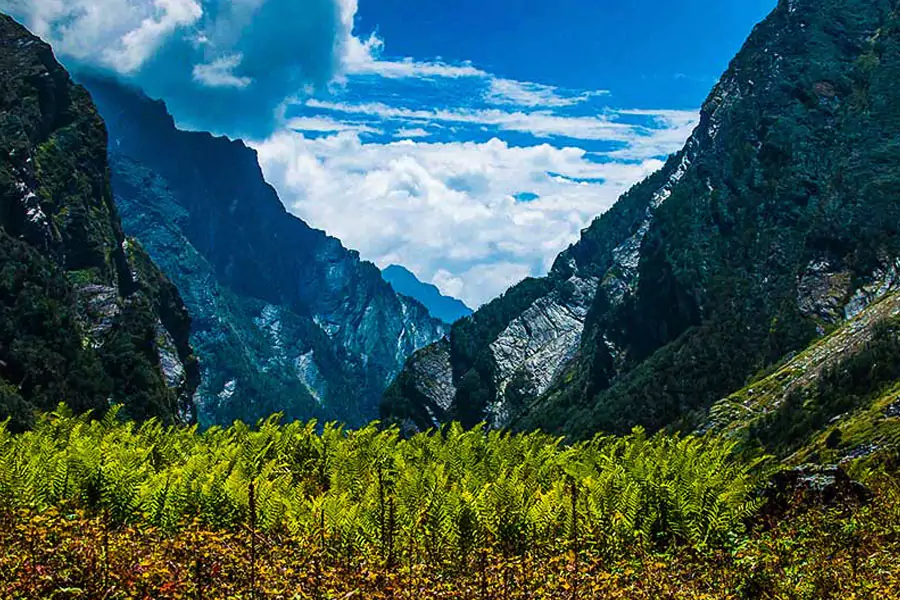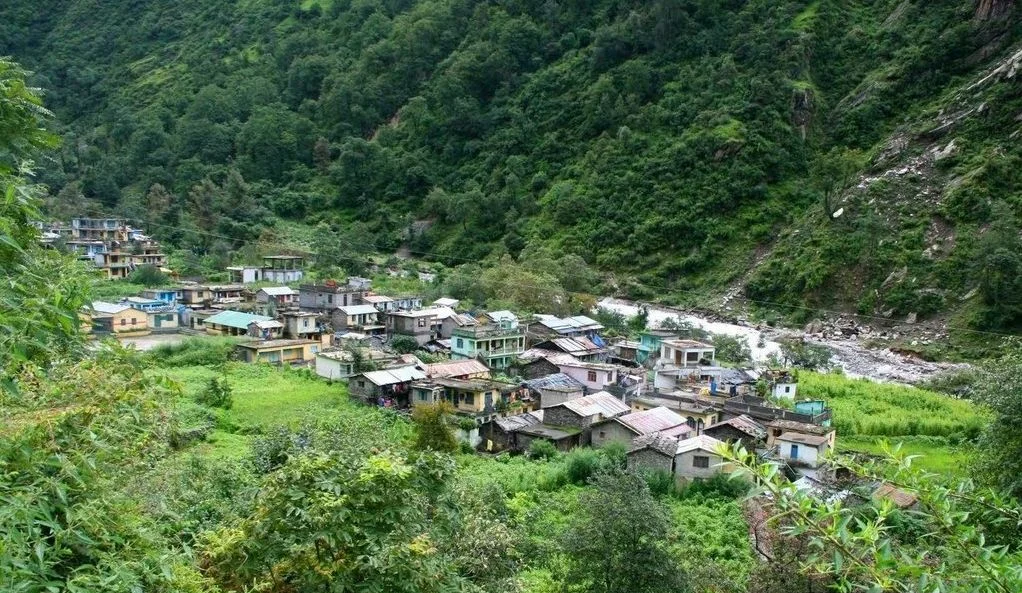Valley of Flowers: A Paradise of Blooming Beauty in Uttarakhand
The Valley of Flowers is located in Utah’s Chamoli district and is one of the most beautiful UNESCO Heritage Sites in the world, known for its colorful meadows fringed with alpine flowers and diverse flora and fauna. This beautiful valley rests at an altitude of 3,658 meters, a freezing mass during the winter, thundering with bright noise from July to September. This adds to its desirability as an attraction for nature lovers, trekkers, and photographers alike. With so many species of wildflowers, and over 500 varieties, such as blue poppies and orchids, this valley features a splendid floral carpet and the rare Brahma Kamal. it also serves as one of the habitats for some threatened species, such as the Asiatic black bear, snow leopard, and blue sheep. Whether you are an adventure seeker or someone who prefers calmness, you will take home a lot when it comes to this valley.
Book here Uttarakhand Tour Packages.
How to Reach the Valley of Flowers
By Air
The nearest airport to the Valley of Flowers is Jolly Grant Airport in Dehradun (DED), located approximately 285 km from the valley. It is well-connected to major Indian cities like Delhi, Mumbai, and Bangalore, with frequent flights. From the airport, you can hire a taxi or take a bus to reach Govindghat, the base camp for the trek. The road journey from Dehradun to Govindghat takes around 10–12 hours, depending on the weather and road conditions.
By Train
The closest railway station is Haridwar Junction, which has excellent connectivity with major cities like Delhi, Kolkata, and Mumbai via express and superfast trains. Haridwar is about 270 km from Govindghat and serves as a major transit point for pilgrims and trekkers heading towards the valley. From Haridwar, travelers can opt for buses, taxis, or shared jeeps to continue their journey toward Govindghat. The scenic drive through the Himalayan foothills takes around 9–10 hours.
By Road
Traveling to the Valley of Flowers by road is an adventurous journey through the rugged terrains of Uttarakhand. From Haridwar or Rishikesh, several private taxis, shared jeeps, and state transport buses operate towards Govindghat via Joshimath. The road passes through stunning landscapes, including Devprayag, Srinagar, Rudraprayag, and Chamoli, offering breathtaking views of rivers and mountains. The 270-km drive from Haridwar to Govindghat takes around 9–10 hours, depending on traffic and weather conditions.
Best Time to Visit the Valley of Flowers
The ideal time to see the Valley of Flowers is between July and September when the valley is full of colorful alpine flowers. From mid-July to August, the valley is a kaleidoscope of colors, and hence, it is the tourist season. The temperature is between 10°C and 20°C during the day, with nights around 5°C, and the occasional monsoon showers enhance the green cover. In June, the snow begins to melt, and by September, the flowers have begun to wane, though the valley still looks beautiful. To have the most stunning experience, visit between mid-July and mid-August, when the flowers are in full bloom.
Top Places to Visit in the Valley of Flowers
1. Valley of Flowers National Park

This UNESCO World Heritage Site is famous for its vibrant alpine meadows filled with over 500 species of wildflowers. Located in Uttarakhand, it remains covered in snow for most of the year and blooms fully during the monsoon season. The valley is surrounded by the Zanskar and Himalayan mountain ranges, offering a breathtaking landscape. Trekking through this paradise gives visitors a chance to witness rare species like blue poppies, cobra lilies, and Brahma Kamal. The serene environment and fresh mountain air make it a must-visit for nature lovers and adventure seekers.
2. Hemkund Sahib

Situated at an altitude of 4,329 meters, Hemkund Sahib is one of the highest Sikh shrines in the world. This sacred gurudwara is nestled beside a crystal-clear glacial lake, surrounded by seven towering snow-clad peaks. Devotees and trekkers alike visit this serene spot to seek spiritual peace and enjoy the panoramic beauty. The trek to Hemkund Sahib is challenging but rewarding, offering glimpses of cascading waterfalls and vibrant flora. Pilgrims also take a dip in the icy waters of the lake, believing it to have divine healing properties.
3. Ghangaria

Ghangaria is the last human settlement before the trek to the Valley of Flowers and Hemkund Sahib begins. It serves as a base camp where visitors can rest, acclimatize, and enjoy basic facilities like hotels and restaurants. Located at an altitude of 3,050 meters, this small village comes alive during the trekking season from June to September. The lush greenery, flowing river, and misty surroundings create a peaceful retreat for travelers. Ponies and porters are available here for those who may find trekking difficult.
4. Pushpawati River

The Pushpawati River flows through the Valley of Flowers, adding to its mesmerizing charm. Originating from the glaciers of Rataban Peak, the river meanders through rocky terrains and green meadows, creating stunning landscapes. The banks of the river are adorned with colorful flowers, enhancing the valley’s beauty during the blooming season. Trekkers often stop here to relax and soak in the peaceful sounds of the flowing water. The river merges with the Lakshman Ganga near Ghangaria, forming an essential part of the valley’s ecosystem.
5. Bhyundar Village

Located at the entrance of the Valley of Flowers trek, Bhyundar Village is a picturesque settlement offering a glimpse of the local Garhwali culture. The village is surrounded by terraced fields, lush forests, and snow-capped peaks, making it a scenic stop for travelers. Traditional wooden houses, friendly villagers, and local food stalls add to the charm of this quaint hamlet. Many trekkers visit Bhyundar to experience the peaceful rural lifestyle before embarking on their adventure. It is also an excellent place to explore local handicrafts and traditional Himalayan cuisine.
Local Cuisine of the Valley of Flowers
1. Aloo Ke Gutke: Aloo Ke Gutke is a traditional Garhwali dish made by stir-frying boiled potatoes with mustard seeds, dry red chilies, and local spices. It is best enjoyed with puri or roti and a side of Bhang Ki Chutney, making it a delicious and comforting meal.
2. Chainsoo: Chainsoo is a protein-rich dish made from roasted black gram dal (urad dal), slow-cooked with spices and ghee. It has a smoky flavor and is typically served with rice, providing warmth and energy in the cold mountain weather.
3. Kafuli: Kafuli is a thick, nutritious curry made from spinach (palak) and fenugreek leaves (methi), cooked with buttermilk and rice paste. This healthy dish is served with rice or ragi roti and is a staple food in the Garhwal region.
4. Phaanu: Phaanu is a lentil-based dish made from mixed pulses like horse gram and arhar dal, soaked overnight and cooked with spices. It is served with steamed rice and ghee, making it a wholesome and energy-boosting meal for trekkers.
5. Bhang Ki Chutney: Bhang Ki Chutney is a flavorful dip made from toasted hemp seeds, garlic, green chilies, and lemon juice. It has a tangy, nutty taste and is commonly eaten with local dishes like Aloo Ke Gutke and Kafuli.
Travel Tips for Visiting the Valley of Flowers
1. Acclimatization and Altitude Sickness: The trek reaches an altitude of over 3,500 meters, so proper acclimatization is essential to avoid altitude sickness. Stay hydrated, take it slow, and spend a night at Ghangaria before heading to the valley or Hemkund Sahib.
2. Fitness Preparation: The trek to the Valley of Flowers requires moderate physical fitness, as it involves trekking 13 km from Govindghat to Ghangaria and an additional 4 km to the valley. Start preparing a month in advance with regular walking, jogging, and light exercises to improve endurance.
3. Pack Essential Gear: Carry trekking shoes with a good grip, rain gear, warm clothes, and a sturdy backpack, as the weather can be unpredictable. Also, pack essentials like a refillable water bottle, energy snacks, a first-aid kit, and trekking poles for a comfortable journey.
4. Accommodation and Food: Accommodation is available in Ghangaria, as camping is not allowed inside the Valley. Small guesthouses and dhabas offer basic food options, so it’s advisable to carry dry snacks, energy bars, and hydration supplements.
5. Permits and Entry Fees: A permit is required to enter the Valley of Flowers National Park, which can be obtained at the Forest Department checkpoint in Ghangaria. The entry fee is valid for three days, so plan your visit accordingly to make the most of your time.
Conclusion
In conclusion, the breathtaking Valley of Flowers is a truly delightful destination for an interesting mix of brilliant alpine fields, diverse vegetation, and calm surroundings. Its location in the Garhwal Himalayas makes it a popular destination for a wide range of visitors, including nature lovers, adventurers, and spiritual travelers. This UNESCO World Heritage Site trip is both tough and rewarding, taking you through picturesque trails and pristine splendor. It is an unforgettable experience for any reason: the unique flowers, the sacred Hemkund Sahib, or the valley’s complete stillness. It is more than just a journey to this valley; it is an immersion into the best of nature’s creations.
Here you can also check our Uttarakhand Tour Packages.
People also ask about the Valley of Flowers
1. Where is this place located?
It is situated in the Chamoli district of Uttarakhand, India, within the Nanda Devi Biosphere Reserve. This region is known for its stunning landscapes, diverse flora, and rich biodiversity.
2. How can I reach this destination?
The journey begins in Haridwar or Rishikesh, followed by a road trip to Govindghat (270 km). From there, it’s a 13-km trek to Ghangaria and an additional 4-km trek to the main site.
3. What is the best time to visit?
The ideal time is July to September when the area is covered in blooming flowers and lush greenery. Avoid early June, as snow is still melting, and after mid-September, as the flowers begin to fade.
4. Is the trek difficult?
The trek is moderate, with a well-marked trail, but involves steep inclines and long walking distances. Basic fitness is necessary, and preparing with walking or endurance exercises is recommended.
5. Is a permit required to enter?
Yes, an entry permit is mandatory and can be obtained at the Forest Department checkpoint in Ghangaria. The permit is valid for three days, with different fees for Indian and foreign tourists.
6. Are accommodations and food available?
Staying options are available in Ghangaria, including guesthouses, hotels, and local eateries. Camping inside the main site is not allowed, so staying overnight in the village is necessary.
7. Is the trek suitable for elderly people and kids?
Elderly individuals and children with good stamina can complete the trek, but it may be challenging. Mules and porters are available from Govindghat to Ghangaria for assistance.
8. What essentials should I pack?
Carry trekking shoes, rain gear, warm clothing, a water bottle, energy snacks, first-aid supplies, and trekking poles. The weather can change rapidly, so proper gear is important.
9. Is a mobile network and internet available?
Mobile connectivity is limited or unavailable in most areas, but BSNL and Jio networks may work in Ghangaria. It’s advisable to inform the family before starting the trek and rely on offline navigation.
10. Can I visit the nearby pilgrimage site along with this place?
Yes, the Sikh pilgrimage site is at a higher altitude, 6 km uphill from Ghangaria. Many visitors explore both locations, though this additional trek is steeper and more demanding.
